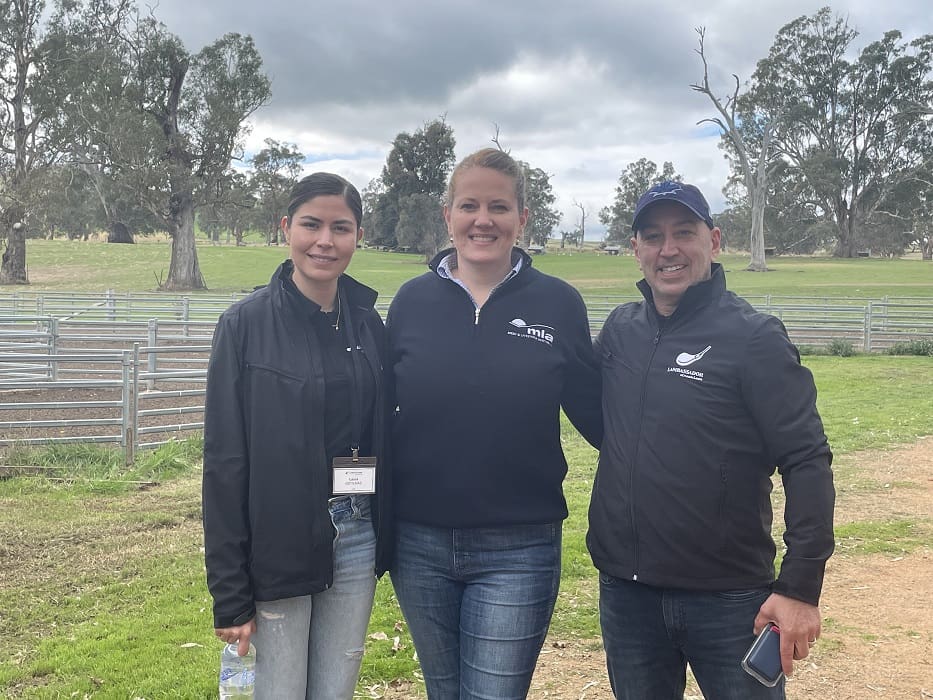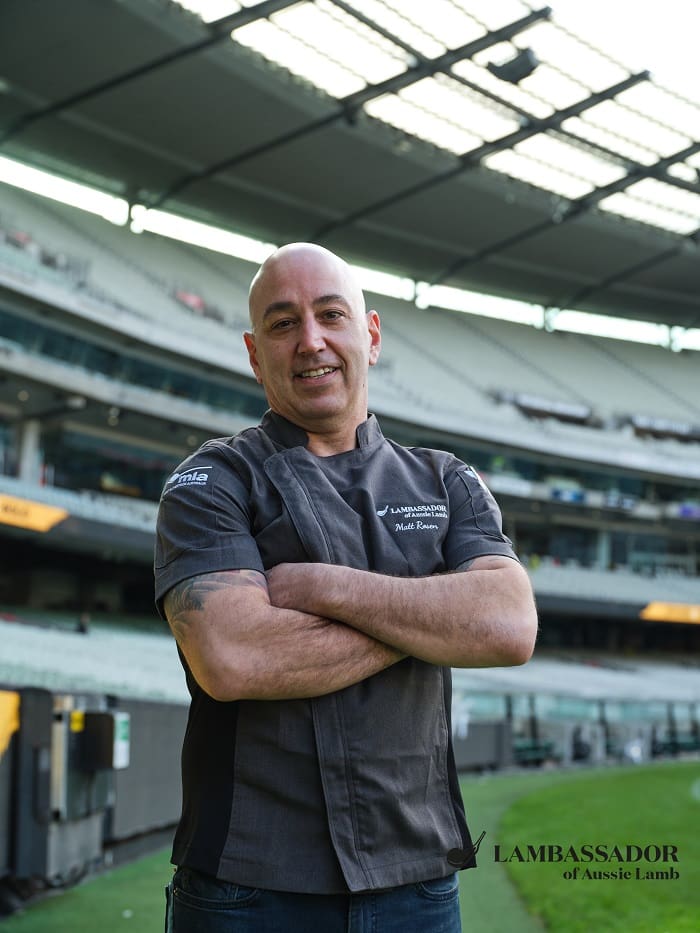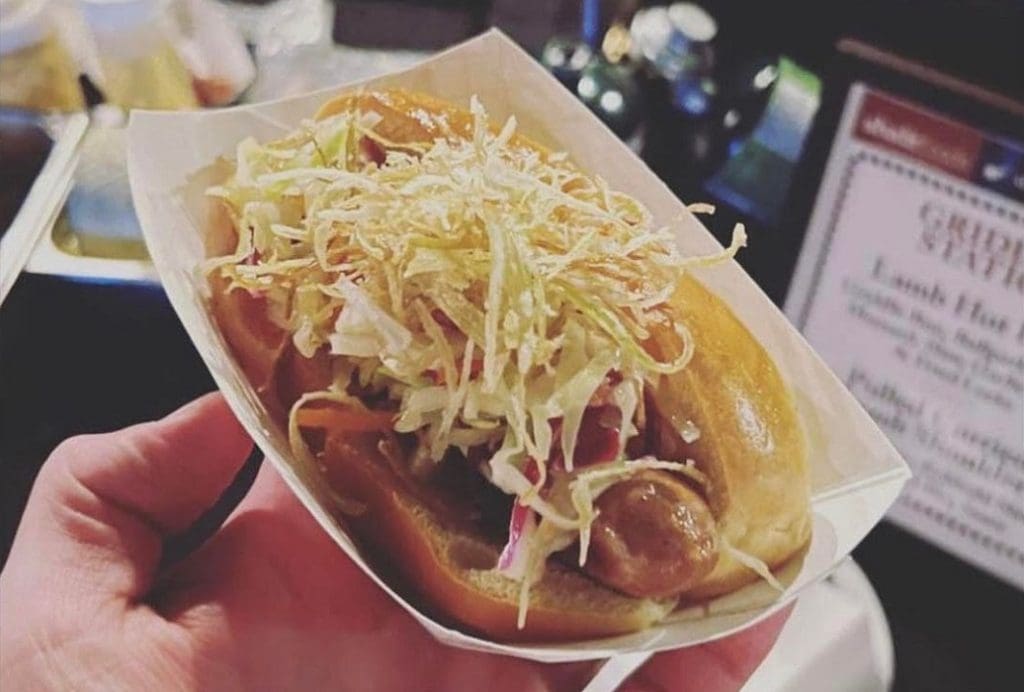
North American Lambassador, San Francisco chef Laura Ozyilmaz, left, with Meat & Livestock Australia’s Sabina Kindler and Canadian Lambassador and chef Matt Rosen during a farm visit.
LAMBASSADOR and Canadian chef Matt Rosen reckons it’s time we all tried a hotdog made with Australian lamb, rather than using the traditional ingredients for the iconic American street food – chicken, beef or pork.
“I’ve used tonnes (of lamb), it’s one of my favourite proteins.”
Matt was in Melbourne with 18 other leading chefs and influencers from Japan, Korea, China, Saudi Arabia, United Kingdom, United States, Canada, Indonesia, Malaysia, Taiwan, Singapore, Thailand, Vietnam, and the Philippines, hosted by Meat & Livestock Australia’s and the Victorian Government as part of MLA’s Lambassador program.
Last week the food professionals were involved in farm visits, butchery demonstrations, cooking masterclasses, and explored Melbourne’s vibrant food scene and local industry trends.
Matt comes from Toronto, capital city of the Canadian province of Ontario, where he works as a private chef and consultant in food service for various restaurants and enterprises. He is also the personal chef of two-time NBA All-Star Pascal Siakam with the Toronto Raptors.
He said up to now 75 percent of the lamb available in Toronto was New Zealand lamb, but now the Australian product is starting to come in. Canadians are also especially proud of their native Ontario lamb.
“But when I use Ontario lamb, it is a bigger lamb, and I find the flavor quite bland, compared to the Australian lamb, which really has a great flavor to it.
“It’s a major differentiating point, I think if you are going to eat lamb you are looking for that flavor difference between other lamb and beef.”

Canadian Lambassador Matt Rosen at the MCG in Melbourne this week.
Matt has been a Lambassador for about a year and last year he helped organize an Australian lamb party on a rooftop in Toronto, with a night market for 60 chefs and foodservice professionals to showcase the versatility of Australian lamb.
“It was really important when we did that that we tried to make attainable dishes … to get people to wrap their head around all the different things you can do with it.
“So we focused on the global melting pot that is Toronto – there are so many different people there from so many different countries – so we tried to do dishes that represented each country.”
These include a Turk lamb wrap, northern Chinese soup dumplings, Thai lamb skewers and an Australian lamb hotdog as representing Toronto street cuisine.
“When I think of what Toronto food is, unfortunately I think of hotdogs, because there are hotdog carts on every corner and that’s what I remember, so we actually challenged ourselves to do a lamb hotdog.”
Australian lamb shoulder was ground, spiced and put into a natural sheep casing and “it was a stand-out dish,” Matt said.
The chef believes there is still room to move in extending the versatility of Australian lamb to world chefs.
“There is a lot of room to grow.
“Lamb seems to be an upper echelon ingredient; chefs use it, but in a fine dining establishment.
“But why can’t it be in every restaurant, where we see beef, pork and chicken?,” he said.
“I think it is up to us as Lambassadors and chefs to show that versatility and show it doesn’t need to be a rack of lamb at $45.
“Here’s a hotdog and if you go to the Middle East they’ve got great Merguez sausages which are lamb and spicy and wonderful,” Matt said.
“I think lamb is in many ways new to North America and people are reticent to learn about new things.
“I just think people need to be reintroduced to the versatility of it.”
In Canada, Ontarian lamb is not sold in supermarkets, presenting an opportunity for Australian lamb to gain market share, Matt said.
Matt said the cost of Australian lamb is not insurmountable in the Northern American market, depending on how it is marketed and used.
“Beef and chicken is expensive, and if consumers choose widely, rather than expensive cuts like a rack, there are other secondary cuts that are achievable and attainable such as a leg.”
Matt said no-one is yet promoting the lamb hotdog.
“But the thing to watch when they ate it was to watch their foreheads go up – they were like ‘oh wow, this is really a great product’.”
Australian lamb should meat used in the Aussie hotdog

Matt Rosen’s Aussie lamb hotdog. Image – MLA.
Matt said boned out Australian lamb shoulder meat was used in his hotdog mix double ground through his meat grinder, adding cayenne pepper, coriander seed, paprika, onion and garlic powder, black pepper, pink curing salt, celery seed and soy protein isolate as a binder and to retain moisture.
“So you get the great moist bite of a hotdog.
“I also have a tremendous respect for hotdog makers now, because it was so hard to do.”
Matt said the role of a Lambassador and chefs is to present Australian lamb in a way that is understood.
“If we can show the rest of the world the versatility of such a great product, a product that is grown with so much love, passion and care, and everybody is so invested in it, it’s not a hard product to get behind.”
Matt said he hasn’t tried some of Australia’s higher intramuscular fat lamb brands coming on the market, but he tended to gravitate to “fattier” cuts such as a rump.
“The way I appreciate the fat is as I appreciate the fat in a (beef) steak, because I think that’s what gives it its unctuousness and that flavor.
“It’s really nice to see a Wagyu style (lamb) coming in, it’s exciting for the future,” he said.
“It shows that the industry is continuing to move forward and it doesn’t settle.”
Matt said he was also impressed with the care and respect shown for the pasture-fed lambs seen during the farm visit last week.
“The pride that is behind it is what makes it a stand-out product.
“When you have a free happy animal, you can get a really great product at the end.”
Check out this MLA North America LinkedIn video post of the farm visit.
Click here to check out Matt’s Australian lamb hotdog recipe.

HAVE YOUR SAY